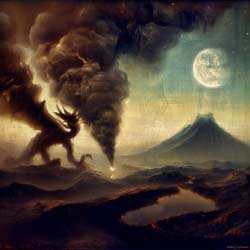 In the shadowy realm of Lovecraftian literature, "The Slaying of the Monster," a collaboration between H.P. Lovecraft and R.H. Barlow, emerges as a tale of grotesque horror and profound regret. The narrative unfurls in an ancient, forsaken castle, where a monstrous entity is rumored to dwell. A band of hunters, driven by fear and ignorance, embark on a perilous quest to exterminate this creature, only to discover the tragic truth too late. The 'monster' they sought to destroy was, in fact, a grotesquely deformed man, living in solitude and despair. The hunters' remorse echoes in the chilling winds of the castle, a haunting testament to their misguided actions.
In the shadowy realm of Lovecraftian literature, "The Slaying of the Monster," a collaboration between H.P. Lovecraft and R.H. Barlow, emerges as a tale of grotesque horror and profound regret. The narrative unfurls in an ancient, forsaken castle, where a monstrous entity is rumored to dwell. A band of hunters, driven by fear and ignorance, embark on a perilous quest to exterminate this creature, only to discover the tragic truth too late. The 'monster' they sought to destroy was, in fact, a grotesquely deformed man, living in solitude and despair. The hunters' remorse echoes in the chilling winds of the castle, a haunting testament to their misguided actions.
The tale is rife with symbolism, the most prominent being the 'monster' itself. This unfortunate being, shunned and feared due to his physical deformity, is a poignant symbol of societal prejudice and the ostracization of those deemed 'other.' The castle, with its dark, foreboding atmosphere, symbolizes the isolation and despair experienced by the 'monster.' The hunters, in their blind pursuit of the 'monster,' represent the destructive power of ignorance and fear.
Drawing upon the insights of scholars such as Joshi, de Camp, Derleth, Cannon, Price, Schultz, Dziemianowicz, Klein, Wymer, Skal, Burleson, Campbell, and Simmons, this review seeks to provide a comprehensive analysis of "The Slaying of the Monster." Their scholarly work has greatly contributed to my understanding of Lovecraft's literature and has provided invaluable insights into the themes, symbolism, and narrative techniques employed in his stories.
“The Slaying of the Monster” by H.P. Lovecraft is a short story that showcases Lovecraft’s unique style of cosmic horror. Here are some strengths and weaknesses of the work:
Strengths:
- Imagery and Atmosphere: Lovecraft excels at creating a sense of dread and unease through his vivid descriptions. The story’s setting in the Hills of the Dragon, the smoke, the lava, and the shaking earth all contribute to a tense and foreboding atmosphere.
- Theme: The story explores themes common in Lovecraft’s work, such as the insignificance of humanity in the face of cosmic horrors. This is seen in the futile efforts of the citizens of Laen to combat a force they can’t comprehend or control.
- Narrative Structure: The story’s narrative structure, with its twist ending, adds to its impact. The citizens’ decision to claim victory despite their failure adds a layer of irony to the tale.
Weaknesses:
- Character Development: As with many of Lovecraft’s stories, character development is minimal. The citizens of Laen are not individualized or given depth.
- Pacing: Some readers might find the pacing slow, as much of the story involves the citizens’ journey to confront the monster.
- Accessibility: Lovecraft’s dense prose and archaic language can be challenging for some readers.
The story is also notable for being one of Lovecraft's few collaborations with another writer. Robert H. Barlow was a young fan who corresponded with Lovecraft since 1931, when he was only thirteen years old. He invited Lovecraft to visit him in Florida in 1934, where they became close friends. They wrote several stories together, including The Night Ocean, The Hoard of the Wizard-Beast, Till A' the Seas, Collapsing Cosmoses, The Battle That Ended the Century, Medusa's Coil (with Zealia Bishop), The Electric Executioner (with Adolphe de Castro), The Horror in the Museum (with Hazel Heald), Out of the Aeons (with Hazel Heald), Winged Death (with Hazel Heald), The Horror in the Museum, and The Diary of Alonzo Typer. Barlow was one of the few people who Lovecraft trusted to continue his legacy after his death, and he inherited most of his papers and manuscripts. However, Barlow committed suicide in 1951, after being blackmailed for his homosexuality. His collection of Lovecraft's works was dispersed and partly destroyed, and some of his own writings were lost.
Critics have pointed out that the story lacks the cosmic horror that is a hallmark of Lovecraft's work. The narrative, while engaging, does not delve into the existential dread and cosmic insignificance that Lovecraft so masterfully evokes in his other stories. However, it is important to note that "The Slaying of the Monster" was a collaborative effort, and the influence of Barlow, who was known for his more traditional approach to horror, is evident.
Despite these criticisms, the story is a compelling exploration of prejudice, fear, and regret. The narrative's focus on the 'monster' as a misunderstood and wronged individual is a departure from Lovecraft's usual portrayal of monstrous entities as malevolent or indifferent cosmic beings. This shift in perspective adds a layer of tragic humanity to the story, setting it apart from Lovecraft's other works.
When compared to Lovecraft's entire corpus, "The Slaying of the Monster" stands out for its exploration of societal prejudice and the consequences of ignorance. While it lacks the cosmic horror of Lovecraft's other works, it offers a more grounded, human-centric narrative that resonates with readers.
The Slaying of the Monster is a unique and refreshing addition to Lovecraft's canon, demonstrating his versatility and creativity as a writer. It is also a valuable contribution to the genre of fantasy and horror, offering a witty and original perspective on the themes of heroism, adventure, and mystery. The story can be enjoyed by fans of Lovecraft's more serious and dark works, as well as by readers who appreciate his lighter and humorous touch.
In conclusion, "The Slaying of the Monster" is a poignant tale of prejudice, fear, and regret. While it may not possess the cosmic horror that Lovecraft is renowned for, it offers a unique perspective on societal prejudice and the tragic consequences of ignorance. It is a testament to Lovecraft's narrative versatility and his ability to evoke empathy and horror in equal measure.
![]()
Research (contextual): I found it very difficult to find any respectable third-party critics who have published anything worth quoting or referencing. It is particularly frustrating, due to the symbolism of discrimination (relative to what we know now of Barlow and his death). This is the last of my Lovecraft series and I had hoped to end on a stronger or more confident note. That said, you may like to explore the following authors and critics:
- S. T. Joshi
- L. Sprague de Camp
- August Derleth
- Peter Cannon
- Robert M. Price
- David E. Schultz
- Stefan Dziemianowicz
- T. E. D. Klein
- N. C. Wymer
- David J. Skal
- D. R. Burleson
- R. W. Campbell
- D. Simmons
Note: The works of H.P. Lovecraft are in the public domain.
The Slaying of the Monster
By H. P. Lovecraft and R. H. Barlow
Great was the clamour in Laen; for smoke had been spied in the Hills of the Dragon. That surely meant the Stirrings of the Monster—the Monster who spat lava and shook the earth as he writhed in its depths. And when the men of Laen spoke together they swore to slay the Monster and keep his fiery breath from searing their minaret-studded city and toppling their alabaster domes.
So it was that by torch-light gathered fully a hundred of the little people, prepared to battle the Evil One in his hidden fast-hold. With the coming of night they began marching in ragged columns into the foot-hills beneath the fulgent lunar rays. Ahead a burning cloud shone clearly through the purple dusk, a guide to their goal.
For the sake of truth it is to be recorded that their spirits sank low long ere they sighted the foe, and as the moon grew dim and the coming of the dawn was heralded by gaudy clouds they wished themselves more than ever at home, dragon or no dragon. But as the sun rose they cheered up slightly, and shifting their spears, resolutely trudged the remaining distance.
Clouds of sulphurous smoke hung pall-like over the world, darkening even the new-risen sun, and always replenished by sullen puffs from the mouth of the Monster. Little tongues of hungry flame made the Laenians move swiftly over the hot stones. “But where is the dragon??” whispered one—fearfully and hoping it would not accept the query as an invitation. In vain they looked—there was nothing solid enough to slay.
So shouldering their weapons, they wearily returned home and there set up a stone tablet graven to this effect—“BEING TROUBLED BY A FIERCE MONSTER THE BRAVE CITIZENS OF LAEN DID SET UPON IT AND SLAY IT IN ITS FEARFUL LAIR SAVING THE LAND FROM A DREADFUL DOOM.”
These words were hard to read when we dug that stone from its deep, ancient layers of encrusting lava.






